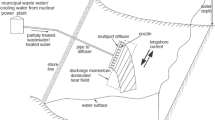Abstract
An electrochemical reactor operated with two identical solution streams injected in opposite directions on the same axis, and leaving it at a normal direction was studied by measuring local and global mass transfer coefficients and visualization of solution flow patterns. This flow configuration was compared to a case where a single stream enters the reactor and leaves it on the same axis. It was found that only the data obtained for the single stream mode can be correlated by the Chilton-Colburn relation, indicating a near laminar boundary layer flow. Global mass transfer coefficients for the single stream mode were found to be slightly higher than those for the interacting jets mode. However, when comparing the two modes by taking into account the dimensionless ratio of the mass transfer coefficient (Sh) to the energy consumption (Eu), it was found that the interacting jets (IJ) mode exhibits a better performance as compared to the single stream mode. The superiority of the IJ mode increases with increasing Reynold's number (Re).
Similar content being viewed by others
Abbreviations
- A, B :
-
adjustable parameters
- b :
-
half width of channel
- C :
-
electrolyte ion concentration
- d :
-
inlet pipe diameter
- d′ :
-
microelectrode diameter
- D :
-
diffusion coefficient
- \(\overline D _{max} \) :
-
maximum value of mean deviation
- E :
-
pumping energy
- Eu :
-
Euler number
- F :
-
Faraday number
- i :
-
current to a single microelectrode on an active wall
- i′ :
-
current to a single microelectrode in an inert wall
- I :
-
global diffusion current
- k :
-
mass transfer coefficient to a single microelectrode in an active wall
- k′ :
-
mass transfer coefficient to a single microelectrode in an inert wall
- K :
-
global mass transfer coefficient
- Q :
-
volumetric flow rate
- Q T :
-
total volumetric flow rate
- R :
-
radius of the electrochemical reactor
- Re :
-
Reynolds number
- s :
-
surface area of a microelectrode
- S :
-
surface area of the working electrode
- Sc :
-
Schmidt number
- Sh :
-
Sherwood number
- V x :
-
axial flow velocity alongx-axis
- V ∞ :
-
flow velocity at large distance from the leading edge
- V :
-
mean flow velocity
- x :
-
axis tangential to the surface
- y :
-
axis normal to the surface
- z :
-
number of electrons transferred in the reaction (z=1 in the present case)
- μ:
-
viscosity
- ρ:
-
specific gravity
- ν:
-
kinematic viscosity (μ/ρ)
- ΔP :
-
pressure drop across the reactor
- ΔV :
-
voltage drop across the reactor
- ST:
-
single stream
- IJ:
-
interacting jets
References
D. R. Gabe and P. A. Makanjuola,J. Appl. Electrochem. 17 (1987) 370.
A. Storck and F. Coeuret,Electrochim. Acta 22 (1977) 1155.
Y. Winograd, A. Solan and M. Toren,Desalination 13 (1973) 171.
A. A. Wragg and A. A. Leontaritis, ‘Electrochemical Cell Design and Optimization Procedures’, Joint Meeting of Dechema and the Society of Chemical Industry, 24–26 September (1990), Bad-Soden, Germany.
A. Tamir, ‘Impinging Streams Contractors: Fundamentals and Applications’,in ‘Advances in transport processes’ Vol. VIII, Elsevier, Amsterdam (1992) pp. 105–195.
A. Tamir,Chem. Eng. Prog. 85 (1989) 53.
A. Tamir and A. Kitron,Chem. Eng. Commun. 50 (1987) 241.
R. J. Kind and K. Suthanthiran,J. Fluid Mech. 58 (1973) 389.
V. A. Denshchikov, V. N. Kondrat'ev and A. N. Romashv,Fluid Dynamics 6 (1978) 924. Translated fromIzv. Akad. Nauk SSSR 6 (1978) 165–7.
H. A. Becker and B. D. Booth,AIChE J. 21 (5) (1975) 949.
M. Abda, ‘Mass transfer to a flat electrode in the impinging jets and single stream regime’, M. Sc. Thesis, The Ben-Gurion University of the Negev, Beer-Sheva, Israel (1991).
J. Nanzer, A. Donizeau and F. Coeuret,J. Appl. Electrochem. 14 (1984) 51.
L. P. Reiss and T. J. Hanratty,AIChE J. 9 (1963) 154.
T. H. Chilton and A. P. Colburn,Ind. Eng. Chem. 26 (1934) 1183.
R. B. Bird, W. E. Stewart, and E. N. Lightfoot, ‘Transport phenomena’, Wiley Int., New York (1960), p. 145.
Author information
Authors and Affiliations
Rights and permissions
About this article
Cite this article
Oren, Y., Abda, M. & Tamir, A. Mass transfer in an electrochemical reactor with two interacting jets. J Appl Electrochem 22, 950–958 (1992). https://doi.org/10.1007/BF01024143
Received:
Revised:
Accepted:
Issue Date:
DOI: https://doi.org/10.1007/BF01024143



